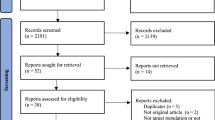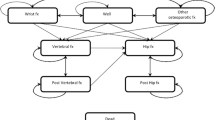Abstract
Randomized, double-blind, controlled studies have shown that treatment with risedronate reduces the risk of vertebral fracture in postmenopausal women with established vertebral osteoporosis. They also show that the drug decreases the risk of non-vertebral fractures in women with osteoporosis. The aim of this study was to investigate the cost-effectiveness of risedronate in postmenopausal women with osteoporosis. A Markov model was applied to a UK setting. Treatment effects were computed by meta-analysis of randomized, controlled trials and given over 5 years to subjects aged between 60 and 80 years. Quality-adjusted life years (QALYs) and life years gained were used as outcome measures. Intervention with risedronate was cost-effective in women aged 60 years and older. Cost savings were also found for postmenopausal women aged 70 years and older with established vertebral osteoporosis (a prior spine fracture and BMD T-score ≤−2.5 SD). This treatment was cost-effective for women aged 65 years and older who had a prior vertebral fracture and a BMD T-score at the threshold of osteoporosis (T-score=−2.5 SD), and in women with a T-score≤−2.5 SD, but without a prior vertebral fracture. In women aged 60–80 years and at the threshold of osteoporosis (T-score=−2.5 SD) but without a prior vertebral fracture, treatment exceeded the threshold for cost-effectiveness. However, if an additional, independent risk factor was assumed (e.g., corticosteroid use) treatment became cost-effective.


Similar content being viewed by others

References
Cummings SR, Melton LJ (2002) Epidemiology and outcomes of osteoporotic fractures. Lancet 359:1761–1767
Johansen A, Stone M (2000) The cost of treating osteoporotic fractures in the United Kingdom female population Osteoporos Int 11:551–552
Delmas PD (2002) Treatment of postmenopausal osteoporosis. Lancet 359:2018–2026
Reginster J, Minne HW, Sorensen OH et al (2000) Randomized trial of the effects of risedronate on vertebral fractures in women with established postmenopausal osteoporosis. Vertebral Efficacy with Risedronate Therapy (VERT) Study Group. Osteoporos Int 11:83–91
Harris ST, Watts NB, Genant HK et al (1999) Effects of risedronate treatment on vertebral and nonvertebral fractures in women with postmenopausal osteoporosis: a randomized controlled trial. Vertebral Efficacy With Risedronate Therapy (VERT) Study Group. JAMA 282:1344–1352
McClung MR, Geusens P, Miller PD et al (2001) Effect of risedronate on the risk of hip fracture in elderly women. Hip Intervention Program Study Group. N Engl J Med 344:333–340
Kanis JA (2002) Diagnosis of osteoporosis and assessment of fracture risk. Lancet 359:1929–1936
Kanis JA, Johnell O, Oden A, Dawson A, De Laet C, Jonsson B (2001) Ten-year probabilities of osteoporotic fractures according to BMD and diagnostic thresholds. Osteoporos Int 12:989–995
Raftery J (2001) NICE: faster access to modern treatments? Analysis of guidance on health technologies. Br Med J 323:1300–1303
Johnell O, Jonsson B, Jonsson L, Black D (2003) Cost effectiveness of alendronate (fosamax) for the treatment of osteoporosis and prevention of fractures. Pharmacoeconomics 21:305–314
Singer BR, McLauchlan GJ, Robinson CM, Christie J (1998) Epidemiology of fractures in 15,000 adults: the influence of age and gender. J Bone Joint Surg 80:243–248
(2002) Incidence of vertebral fracture in Europe: results from the European Prospective Osteoporosis Study (EPOS). J Bone Miner Res 17:716–724
Van der Klift M, De Laet CE, McCloskey EV, Hofman A, Pols HA (2002) The incidence of vertebral fractures in men and women: the Rotterdam Study. J Bone Miner Res 17:1051–1056
Kanis JA, Oden A, Johnell O, Jonsson B, de Laet C, Dawson A (2001) The burden of osteoporotic fractures: a method for setting intervention thresholds. Osteoporos Int 12:417–427
Lindsay R, Silverman SL, Cooper C et al (2001) Risk of new vertebral fracture in the year following a fracture. JAMA 285:320–323
Kanis JA, Black D, Cooper C et al (2002) A new approach to the development of assessment guidelines for osteoporosis. Osteoporos Int 13:527–536
Marshall D, Johnell O, Wedel H (1996) Meta-analysis of how well measures of bone mineral density predict occurrence of osteoporotic fractures. Br Med J 312:1254–1259
National Osteoporosis Foundation (1998) Osteoporosis: review of the evidence for prevention, diagnosis and treatment and cost-effective analysis. Osteoporos Int [Suppl 4] 8:S7–80
Kanis JA, Brazier J, Calvert N, Lloyd-Jones M, Stevenson M (2002) Treatment of established osteoporosis: a systematic review and cost utility analysis. Health Technol Assess 6:1-255
Kanis JA, Johnell O, Oden A, Jonsson B, Dawson A, Dere W (2000) Risk of hip fracture derived from relative risks: an analysis applied to the population of Sweden. Osteoporos Int 11:120–127
Klotzbuecher CM, Ross PD, Landsman PB, Abbott TA 3rd, Berger M (2000) Patients with prior fractures have an increased risk of future fractures: a summary of the literature and statistical synthesis. J Bone Miner Res 15:721–739
Melton LJ 3rd, Lane AW, Cooper C, Eastell R, O’Fallon WM, Riggs BL (1993) Prevalence and incidence of vertebral deformities. Osteoporos Int 3:113–119
Kanis J, Johansson H, Oden A et al (2004) A meta-analysis of prior corticosteroid use and fracture risk. J Bone Miner Res
Cranny A, Tugwell P, Adachi JD et al (2002) Meta-analysis of risedronate for the treatment of postmenopausal osteoporosis. Endocr Rev 23:517–523
Tonino RP, Meunier PJ, Emkey R et al (2000) Skeletal benefits of alendronate: 7-year treatment of postmenopausal osteoporotic women. Phase III Osteoporosis Treatment Study Group. J Clin Endocrinol Metab 85:3109–3115
Stock JL, Bell NH, Chesnut CH 3rd et al (1997) Increments in bone mineral density of the lumbar spine and hip and suppression of bone turnover are maintained after discontinuation of alendronate in postmenopausal women. Am J Med 103:291–297
www.nice.org.uk
Dolan P, Torgerson DJ (1998) The cost of treating osteoporotic fractures in the United Kingdom female population. Osteoporos Int 8:611–617
Jonsson B, Christiansen C, Johnell O, Hedbrandt J, Karlsson G (1996) Cost-effectiveness of fracture prevention in established osteoporosis. Scand J Rheumatol Suppl 103:30–38; discussion 39–40
Netten A, Rees T, Harrison G (2001) Unit cost of health and social care. Personal services research unit. University of Kent (www.ukc.ac.uk/PSSRU)
De Laet CE, van Hout BA, Burger H, Weel AE, Hofman A, Pols HA (1999) Incremental cost of medical care after hip fracture and first vertebral fracture: the Rotterdam study. Osteoporos Int 10:66–72
World Bank (2000) World development indicators—relative prices and exchange rates. World Bank, Washington DC
Royal College of Nursing (2001) http://www.doh.gov.uk/nhsexec/refcosts.htm
Tables (2002) Government Actuary’s Department
Oden A, Dawson A, Dere W, Johnell O, Jonsson B, Kanis JA (1998) Lifetime risk of hip fractures is underestimated. Osteoporos Int 8:599–603
Kanis JA, Oden A, Johnell O, De Laet C, Jonsson B, Oglesby AK (2003) The components of excess mortality after hip fracture. Bone 32:468–473
Center JR, Nguyen TV, Schneider D, Sambrook PN, Eisman JA (1999) Mortality after all major types of osteoporotic fracture in men and women: an observational study. Lancet 353:878–882
Kanis JA, Oden A, Johnell O, De Laet C, Jonsson B, Oglesby AK (2004) Excess mortality after hospitalization for vertebral fracture. Osteoporos Int 15:108–112
Cooper C, Atkinson EJ, Jacobsen SJ, O’Fallon WM, Melton LJ 3rd (1993) Population-based study of survival after osteoporotic fractures. Am J Epidemiol 137(9):1001–1005
Cauley JA, Thompson DE, Ensrud KC, Scott JC, Black D (2000) Risk of mortality following clinical fractures. Osteoporos Int 11:556–561
Zethraeus N, Borgstrom F, Johnell O, Kanis J, Jonsson B (2002) Costs and quality of life associated with osteoporosis-related fractures and results from a Swedish survey. Working-paper series in Economics and Finance, Report 512. Centre for Health Economics, Stockholm.
Kanis J, Johnell O, Oden A et al (2004) Risk and burden of vertebral fractures in Sweden. Osteoporos Int 15:20–26
Lundberg L, Johannesson M, Iscacson DGL, Borgquist L (1999) Health state utilities in a general population in relation to age, gender and socio-economic factors. Eur J Public Health 9:211–217
Kind P, Dolan P, Gudex C, Williams A (1998) Variations in population health status: results from a United Kingdom national questionnaire survey. Br Med J 316:736–741
Brazier JE, Green C, Kanis JA (2002) A systematic review of health state utility values for osteoporosis-related conditions. Osteoporos Int 13:768–776
Gabriel SE, Kneeland TS, Melton LJ 3rd, Moncur MM, Ettinger B, Tosteson AN (1999) Health-related quality of life in economic evaluations for osteoporosis: whose values should we use? Med Decis Making 19:141–148
Cranny A, Coyle D, Wells G, Jolly E, Tugwell P (2001) The psychometric properties of patient preferences in osteoporosis. J Rheumatol 28:132–137
Merlino LA, Bagchi I, Taylor TN et al (2001) Preferences for fractures and other glucocorticoid-associated adverse events among rheumatoid arthritis patients. Med Decis Making 21:122–132
Oleksik A, Lips P, Dawson A et al (2000) Health-related quality of life in postmenopausal women with low BMD with or without prevalent vertebral fractures. J Bone Miner Res 15:1384–1392
Tosteson AN, Gabriel SE, Grove MR, Moncur MM, Kneeland TS, Melton LJ 3rd (2001) Impact of hip and vertebral fractures on quality-adjusted life years. Osteoporos Int 12:1042–1049
Hall SE, Criddle RA, Comito TL, Prince RL (1999) A case-control study of quality of life and functional impairment in women with long-standing vertebral osteoporotic fracture. Osteoporos Int 9:508–515
Iglesias CP, Torgerson DJ, Bearne A, Bose U (2002) The cost utility of bisphosphonate treatment in established osteoporosis. Q J Med 95:305–311
Borgstrom F, Zethraeus N (2003) Economic assessment based on a clinical study of risedronate. Fracture prevention in elderly women with osteoporosis is cost-effective. Lakartidningen 100:36–40
Royal College of Physicians (1999) Osteoporosis: clinical guidelines for prevention and treatment. Royal College of Physicians, London
www.nof.org
Compston JE, Barlow D, Brown P et al (2002) Glucorticoid-induced osteoporosis. Guidelines for prevention and treatment. Bone and Tooth Society of Great Britain. National Osteoporosis Society, Royal College of Physicians, London
Jonsson B, Kanis J, Dawson A, Oden A, Johnell O (1999) Effect and offset of effect of treatments for hip fracture on health outcomes. Osteoporos Int 10:193–199
Kanis JA, Johnell O, De Laet C, Jonsson B, Oden A, Ogelsby AK (2002) International variations in hip fracture probabilities: implications for risk assessment. J Bone Miner Res 17:1237–1244
Author information
Authors and Affiliations
Corresponding author
Rights and permissions
About this article
Cite this article
Kanis, J.A., Borgstrom, F., Johnell, O. et al. Cost-effectiveness of risedronate for the treatment of osteoporosis and prevention of fractures in postmenopausal women. Osteoporos Int 15, 862–871 (2004). https://doi.org/10.1007/s00198-004-1643-0
Received:
Accepted:
Published:
Issue Date:
DOI: https://doi.org/10.1007/s00198-004-1643-0



